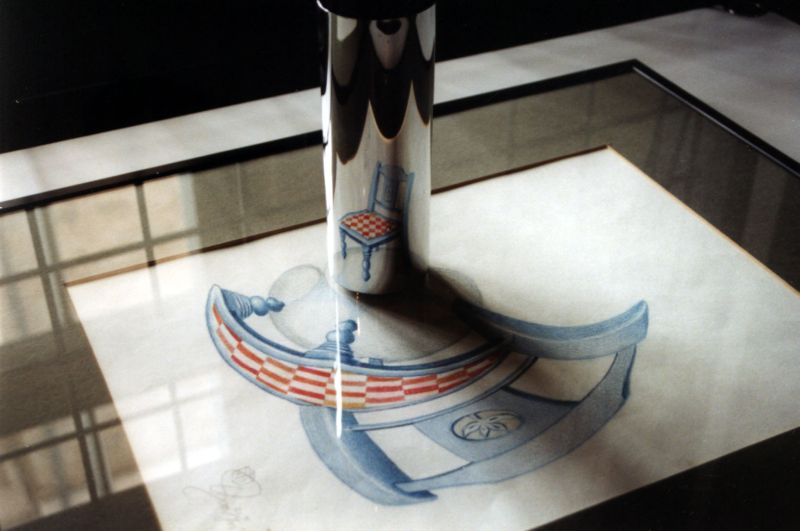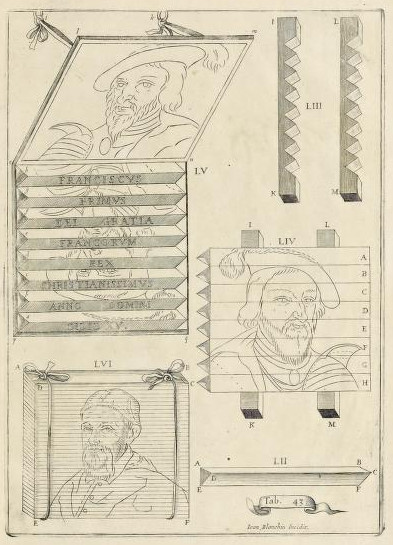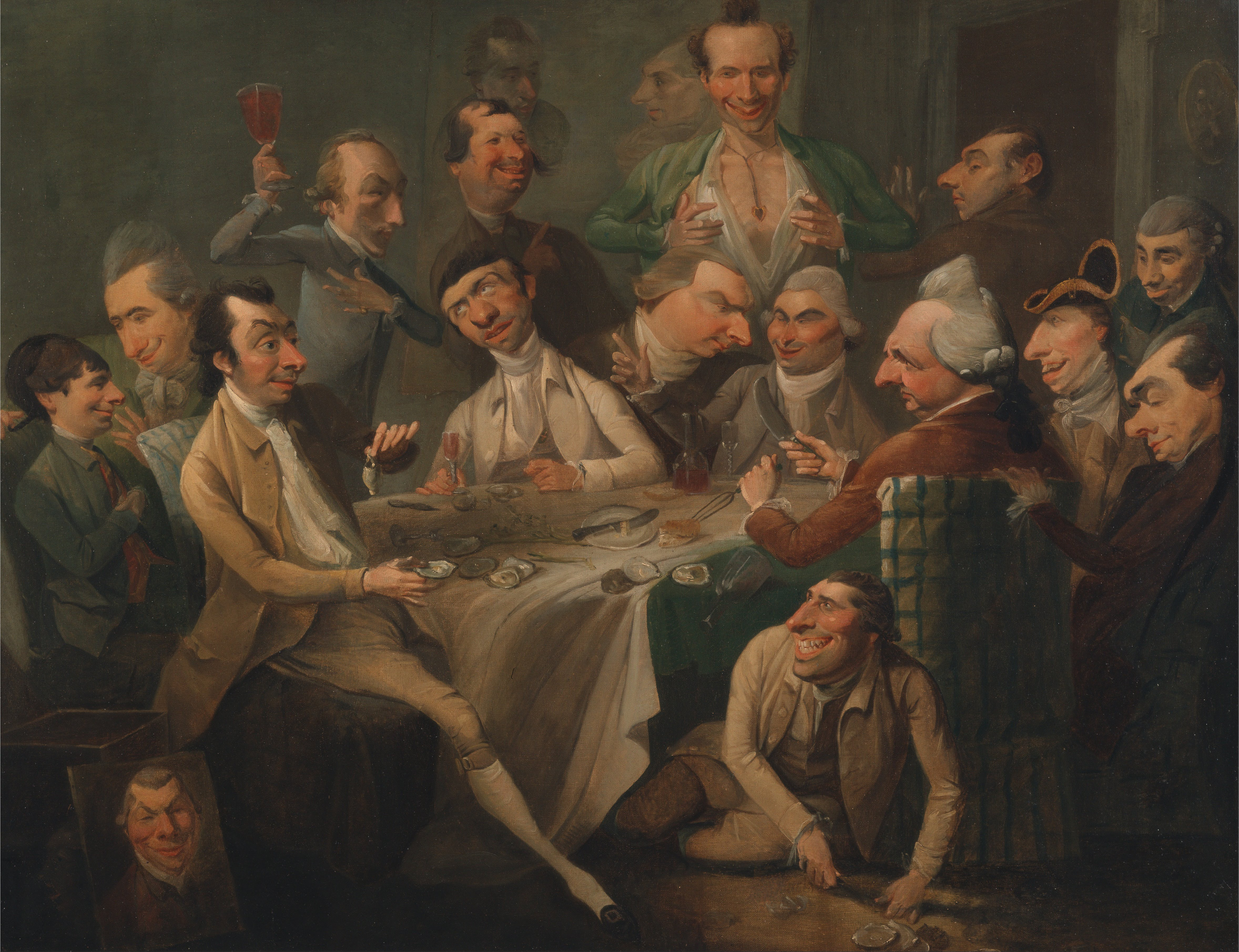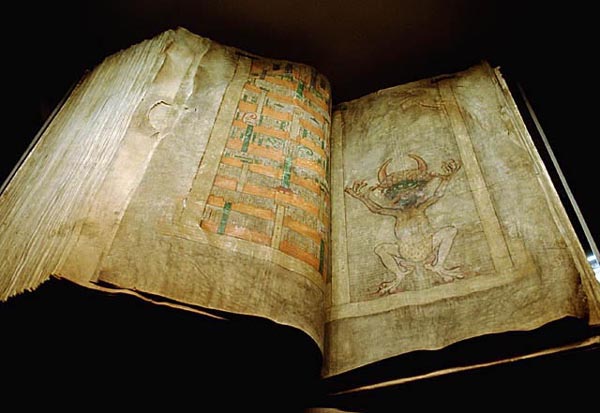|
Anamorphosis
Anamorphosis is a distorted projection that requires the viewer to occupy a specific vantage point, use special devices, or both to view a recognizable image. It is used in painting, photography, sculpture and installation, toys, and film special effects. The word is derived from the Greek prefix ''ana-'', meaning "back" or "again", and the word ''morphe'', meaning "shape" or "form". Extreme anamorphosis has been used by artists to disguise caricatures, erotic and scatological scenes, and other furtive images from a casual spectator, while revealing an undistorted image to the knowledgeable viewer. Types of projection There are two main types of anamorphosis: ''perspective'' (oblique) and ''mirror'' (catoptric). More complex anamorphoses can be devised using distorted lenses, mirrors, or other optical transformations. An oblique anamorphism forms an affine transformation of the subject. Early examples of Perspective (graphical), perspectival anamorphosis date to the Renaissa ... [...More Info...] [...Related Items...] OR: [Wikipedia] [Google] [Baidu] |
Tabula Scalata
Tabula scalata are pictures with two images divided into strips on different sides of a corrugated carrier. Each image can be viewed correctly from a certain angle. Most tabula scalata have the images in vertical lines so the picture seems to change from one image to another while walking past it. The top image on versions with horizontal strips could be seen via a mirror placed above the picture. Some tabula scalata have the two pictures matched in shape and size, which practically creates a simple type of morphing effect when the viewing angle changes. A variation, known as "triscenorama" or "tabula stritta" has three images: two on each side of perpendicular slats in front of the third picture. The basic idea of tabula scalata and tabula stritta is somewhat similar to that of the ancient triangular periaktos theatre coulisse, and that of the modern day Trivision billboard and lenticular printing. Terminology The Latin term "Tabula scalata" was introduced in 1646 by Athanasiu ... [...More Info...] [...Related Items...] OR: [Wikipedia] [Google] [Baidu] |
The Ambassadors (Holbein)
''The Ambassadors'' is a 1533 painting by Hans Holbein the Younger. Also known as ''Jean de Dinteville and Georges de Selve'', after the two people it portrays, it was created in the Tudor period, in the same year Elizabeth I was born. Franny Moyle speculates that Elizabeth's mother, Anne Boleyn, then Queen of England, might have commissioned it as a gift for Jean de Dinteville, the French ambassador, portrayed on the left. De Selve was a Catholic Bishop. As well as being a double portrait, the painting contains a still life of meticulously rendered objects, the meaning of which is the cause of much debate. An array of expensive scientific objects, related to knowing the time and the cosmos are prominently displayed. Several refer to Rome, the seat of the Pope. A second shelf of objects shows a lute with a broken string, a symbol of discord, next to a hymnal composed by Martin Luther. It incorporates one of the best-known examples of anamorphosis in painting. While most scholars ... [...More Info...] [...Related Items...] OR: [Wikipedia] [Google] [Baidu] |
Mirror
A mirror, also known as a looking glass, is an object that Reflection (physics), reflects an image. Light that bounces off a mirror forms an image of whatever is in front of it, which is then focused through the lens of the eye or a camera. Mirrors reverse the direction of light at an angle equal to its incidence. This allows the viewer to see themselves or objects behind them, or even objects that are at an angle from them but out of their field of view, such as around a corner. Natural mirrors have existed since Prehistory, prehistoric times, such as the surface of water, but people have been manufacturing mirrors out of a variety of materials for thousands of years, like stone, metals, and glass. In modern mirrors, metals like silver or aluminium are often used due to their high reflectivity, applied as a thin coating on glass because of its naturally smooth and very Hardness (materials science), hard surface. A mirror is a Wave (physics), wave reflector. Light consists ... [...More Info...] [...Related Items...] OR: [Wikipedia] [Google] [Baidu] |
Holbein Skull
Holbein may refer to: * Holbein (surname) * Holbein, Saskatchewan, a small village in Canada *Holbein carpet Holbein carpets are a type of Ottoman Empire, Ottoman carpet taking their name from Hans Holbein the Younger, due to their Oriental carpets in Renaissance painting, depiction in European Renaissance paintings, although they are shown in paintings ..., a type of Ottoman carpet * Holbein stitch, a type of embroidery stitch * Holbein (crater), a crater on Mercury {{Disambig ... [...More Info...] [...Related Items...] OR: [Wikipedia] [Google] [Baidu] |
Leonardo Da Vinci
Leonardo di ser Piero da Vinci (15 April 1452 - 2 May 1519) was an Italian polymath of the High Renaissance who was active as a painter, draughtsman, engineer, scientist, theorist, sculptor, and architect. While his fame initially rested on his achievements as a painter, he has also become known for #Journals and notes, his notebooks, in which he made drawings and notes on a variety of subjects, including anatomy, astronomy, botany, cartography, painting, and palaeontology. Leonardo is widely regarded to have been a genius who epitomised the Renaissance humanism, Renaissance humanist ideal, and his List of works by Leonardo da Vinci, collective works comprise a contribution to later generations of artists matched only by that of his younger contemporary Michelangelo. Born out of wedlock to a successful notary and a lower-class woman in, or near, Vinci, Tuscany, Vinci, he was educated in Florence by the Italian painter and sculptor Andrea del Verrocchio. He began his career ... [...More Info...] [...Related Items...] OR: [Wikipedia] [Google] [Baidu] |
Codex Atlanticus
The Codex Atlanticus (Atlantic Codex) is a 12-volume, bound set of drawings and writings (in Italian) by Leonardo da Vinci, the largest single set. Its name indicates the large paper used to preserve original Leonardo notebook pages, which was used for atlases. It comprises 1,119 leaves dating from 1478 to 1519, the contents covering a great variety of subjects, from flight to weaponry to musical instruments and from mathematics to botany. This codex was gathered in the late 16th century by the sculptor Pompeo Leoni, who dismembered some of Leonardo's notebooks in its formation. It is now in the Biblioteca Ambrosiana in Milan. Description The Codex Atlanticus is the largest single collection of drawings and writings (in Italian) by polymath Leonardo da Vinci, containing 1,119 paper leaves (2,238 pages) arranged into 12 leather-bound volumes. Its size and scope has led art historian Carlo Pedretti to recognize it as the most important of Leonardo's manuscripts. The pages are ... [...More Info...] [...Related Items...] OR: [Wikipedia] [Google] [Baidu] |
Giacomo Barozzi Da Vignola
Giacomo Barozzi da Vignola ( , , ; 1 October 15077 July 1573), often simply called Vignola, was one of the great Italian architects of 16th century Mannerism. His two great masterpieces are the Villa Farnese at Caprarola and the Jesuits' Church of the Gesù in Rome. The three architects who spread the Italian Renaissance style throughout Western Europe are Vignola, Serlio and Palladio. He is often considered the most important architect in Rome in the Mannerist era. Biography Jacopo Barozzi was born at Vignola, near Modena (Emilia-Romagna). He began his career as an architect in Bologna, supporting himself by painting and making perspective templates for inlay craftsmen. He made his first trip to Rome in 1536 to make measured drawings of Roman temples, with a thought to publish an illustrated Vitruvius. Then François I called him to Fontainebleau, where he spent the years 1541–1543. Here he probably met his fellow Bolognese, the architect Sebastiano Serlio and the ... [...More Info...] [...Related Items...] OR: [Wikipedia] [Google] [Baidu] |
Tommaso Laureti
Tommaso Laureti, often called Tommaso Laureti Siciliano ( 1530 – 22 September 1602), was an Italian painter from Sicily who trained in the atelier of the aged Sebastiano del Piombo and worked in Bologna. From 1582, he worked for papal patrons in Rome in a Michelangelo-inspired style with special skill in illusionistic perspective, that in his Roman work avoided all but traces of Mannerism. Biography Laureti was born in Palermo, Sicily. After his first master's death in 1547, he settled in Bologna, introducing illusionistic perspective paintings on ceilings to the city, notably an ''Alexander the Great'' ceiling with a painted architectural setting in Palazzo Vizzani. He painted a ''Transportation of the Body of Saint Augustine'' for the church of San Giacomo Maggiore in Bologna. The Mannerist structural elements of the marble and bronze ''Fountain of Neptune'' in Bologna, which is surmounted by Giambologna's ''Neptune'', completed in 1566, were based on a 1563 drawing by La ... [...More Info...] [...Related Items...] OR: [Wikipedia] [Google] [Baidu] |
Caricature
A caricature is a rendered image showing the features of its subject in a simplified or exaggerated way through sketching, pencil strokes, or other artistic drawings (compare to: cartoon). Caricatures can be either insulting or complimentary, and can serve a political purpose, be drawn solely for entertainment, or for a combination of both. Caricatures of politicians are commonly used in newspapers and news magazines as political cartoons, while caricatures of movie stars are often found in entertainment magazines. In literature, a ''caricature'' is a distorted representation of a person in a way that exaggeration, exaggerates some characteristics and oversimplifies others. Etymology The term is derived for the Italian ''caricare''—to charge or load. An early definition occurs in the English doctor Thomas Browne's ''Christian Morals'', published posthumously in 1716. with the footnote: Thus, the word "caricature" essentially means a "loaded portrait". In 18th-centu ... [...More Info...] [...Related Items...] OR: [Wikipedia] [Google] [Baidu] |
Codex Atlanticus - 000R-98
The codex (: codices ) was the historical ancestor format of the modern book. Technically, the vast majority of modern books use the codex format of a stack of pages bound at one edge, along the side of the text. But the term ''codex'' is now reserved for older manuscript books, which mostly used sheets of vellum, parchment, or papyrus, rather than paper. By convention, the term is also used for any Aztec codex (although the earlier examples do not actually use the codex format), Maya codices and other pre-Columbian manuscripts. Library practices have led to many European manuscripts having "codex" as part of their usual name, as with the Codex Gigas, while most do not. Modern books are divided into paperback (or softback) and those bound with stiff boards, called hardbacks. Elaborate historical bindings are called treasure bindings. At least in the Western world, the main alternative to the paged codex format for a long document was the continuous scroll, which was the domina ... [...More Info...] [...Related Items...] OR: [Wikipedia] [Google] [Baidu] |
Hans Holbein The Younger
Hans Holbein the Younger ( , ; ; – between 7 October and 29 November 1543) was a German-Swiss painter and printmaker who worked in a Northern Renaissance style, and is considered one of the greatest portraitists of the 16th century. He also produced religious art, satire, and Reformation propaganda, and he made a significant contribution to the history of book design. He is called "the Younger" to distinguish him from his father Hans Holbein the Elder, an accomplished painter of the International Gothic, Late Gothic school. Holbein was born in Augsburg but worked mainly in Basel as a young artist. At first, he painted murals and religious works, and designed stained glass windows and illustrations for books from the printer Johann Froben. He also painted an occasional portrait, making his international mark with portraits of humanist Desiderius Erasmus of Rotterdam. When the Reformation reached Basel, Holbein worked for reformist clients while continuing to serve traditi ... [...More Info...] [...Related Items...] OR: [Wikipedia] [Google] [Baidu] |








